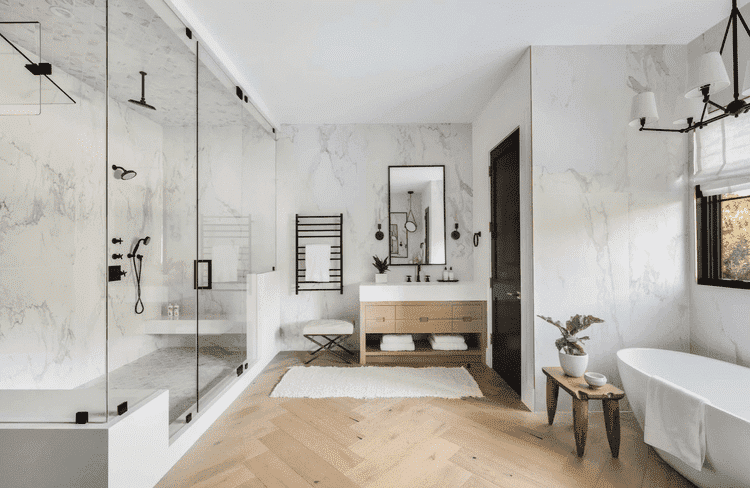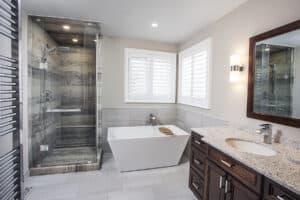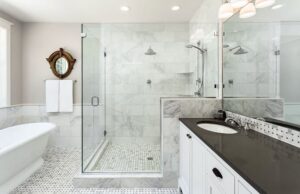The Need for Bathroom Renovation
Renovating a bathroom is a significant project that can dramatically transform a home or commercial property. The reasons for undertaking bathroom renovations can be diverse, ranging from practical concerns about aging plumbing and fixtures, aesthetic considerations linked to outdated designs, and strategic objectives related to enhancing property value.
Aging Plumbing and Fixtures
One of the compelling reasons to renovate a bathroom is to address issues with aging plumbing and fixtures. Over time, pipes can corrode, faucets can leak, and fixtures can become inefficient or break down completely. This can lead to water wastage, higher utility bills, and potential damage to the property. Updating these elements not only ensures the bathroom functions optimally but also gives the opportunity to incorporate modern and energy-efficient fixtures, contributing to significant long-term savings. Check out our guide on choosing the right materials for your bathroom renovation.
Outdated Designs
Another common reason for bathroom renovation is to modernize outdated designs. Bathrooms that were stylish and functional a couple of decades ago may no longer meet current tastes or needs. Revamping the bathroom can create a more pleasing and contemporary aesthetic while also improving functionality. This includes making changes to the layout, replacing old tiles, or installing new fixtures and fittings. For inspiration, one can explore our article on modernizing your space: top bathroom renovation trends of 2024.
Enhancing Property Value
Finally, bathroom renovations are often undertaken as a strategic investment to enhance property value. An upgraded bathroom can make a property more appealing to potential buyers or renters, leading to higher returns on investment. Even simple improvements like adding a fresh coat of paint, replacing old fixtures, or installing a new vanity can make a significant difference to the perceived value of the property. For tips on how to achieve luxury on a budget, visit our article on luxury on a budget: tips for an upscale bathroom renovation.
In conclusion, whether it’s due to aging plumbing and fixtures, outdated designs, or the desire to enhance property value, the decision to undertake a bathroom renovation can be a wise one. Proper planning, budgeting, and execution can ensure the project’s success and help you transform your bathroom from dated to dazzling. For a comprehensive guide on the renovation process, refer to our article on bathroom renovations: a step-by-step guide for homeowners.
Planning for Bathroom Renovation
The key to transforming old bathrooms from dated to dazzling lies in careful planning. A well-thought-out plan can ensure that your bathroom renovation aligns with your goals, stays within budget, and results in a design that enhances both functionality and style.
Setting Goals
The first step in planning a bathroom renovation is to set clear goals. This involves determining the scope of the project, which could range from a minor update to a complete overhaul. It’s important to identify the elements that need upgrading, the features to be added, and the existing components that might be retained.
For example, your goals may include improving the bathroom’s functionality, enhancing its aesthetics, increasing storage space, or incorporating eco-friendly features. By defining your goals, you can make informed decisions throughout the renovation process.
Budget Planning
Budget planning is an integral part of any renovation project. It’s essential to consider all costs involved, from labor and materials to fixtures and unexpected expenses. This will help avoid unnecessary financial strain and ensure the project proceeds smoothly.
Consider the value that each element adds to your bathroom and prioritize accordingly. It’s wise to allocate a portion of your budget for unexpected expenses that may arise during the renovation. For more detailed guidance on budget planning, you can refer to our article on cost-effective bathroom renovations: tips for budget planning.
Choosing a Style and Design
Finally, choosing a style and design for your bathroom is where you can truly let your creativity shine. Whether you prefer a modern and minimalist design, a rustic and natural look, or an elegant and luxurious aesthetic, the choice is up to you.
Consider the overall design of your property to ensure the renovated bathroom complements it. Factor in the size of the bathroom, as certain designs might be better suited for smaller or larger spaces. You might also want to consider current trends, which can be found in our article on modernizing your space: top bathroom renovation trends of 2024.
Planning your bathroom renovation can be an exciting process. By setting clear goals, planning your budget, and choosing a style that reflects your taste, you’re on your way to revamping your old bathroom with style. Remember, it’s not just about the destination but also about the journey. Happy planning!
Tackling Major Elements in a Bathroom
When revamping old bathrooms from dated to dazzling, there are several major components that typically require attention. These include the bathtub or shower, vanity, toilet, and flooring.
Replacing Bathtub or Shower
The bathtub or shower is often the most prominent feature in a bathroom. Replacing an outdated bathtub or shower enclosure can significantly enhance the overall aesthetic. When choosing a new bathtub or shower, consider the available space, the desired style, and the needs of the users. For instance, a freestanding tub might be suitable for a spacious, luxurious bathroom, while a compact, walk-in shower might be a better fit for a smaller space. You may also want to consider options like a wet room or a barrier-free shower for enhanced accessibility. For more ideas, explore our bathroom renovations guide.
Redoing the Vanity
The vanity area, which typically includes the sink and storage, is another critical component in a bathroom. An outdated vanity can be replaced with a modern design that offers improved functionality and style. Consider options like a floating vanity for a sleek, minimalist look or a furniture-style vanity for a traditional feel. The choice of materials, colors, and finishes can also significantly impact the overall look of the space. For tips on choosing the right materials, visit our article on choosing the right materials for your bathroom renovation.
Upgrading the Toilet
While often overlooked, upgrading the toilet can contribute to the overall transformation of the bathroom. Modern toilets come in various designs, from one-piece and two-piece options to wall-mounted versions. They also offer features like water efficiency, self-cleaning, and comfort-height seating. Consider incorporating these features to enhance the functionality of the bathroom.
Flooring and Tiles
Replacing the flooring and tiles is another major aspect of a bathroom remodel. Consider durable and water-resistant materials like porcelain or ceramic tiles for the floor. For the walls, you could opt for tiles, paint, or a combination of both. Consider using tiles in wet areas like the shower enclosure and paint in drier areas. The choice of colors and patterns can add visual interest and character to the space.
These major elements play a critical role in the bathroom renovation process. By carefully considering each aspect and making the right choices, one can successfully transform an old bathroom into a stylish and functional space. For more tips and advice, check out our step-by-step guide for homeowners undertaking bathroom renovations.
Adding Style to Your Bathroom
Transforming a bathroom from dated to dazzling involves not only focusing on the major elements like the bathtub, vanity, and tiles but also on aspects that add style and character to the space. This includes the choice of colors, lighting, and accessories.
Incorporating Colors
Color plays a crucial role in setting the mood and tone of a bathroom. For a serene and calming environment, consider using cool tones such as blues and greens. On the other hand, warmer hues like yellows, oranges, or shades of brown can create a cozy and inviting ambiance.
Neutral colors such as whites, grays, and beiges offer a timeless appeal and provide a perfect backdrop for bold accents. For those looking to make a statement, incorporating a feature wall in a vibrant color or pattern can add visual interest.
When selecting colors, it’s important to consider the overall design theme of the bathroom. For instance, a minimalist or modern bathroom may benefit from a monochrome color scheme, while a vintage-style bathroom might look best with pastel or muted tones.
Choosing Lighting
Lighting is another key aspect that can significantly influence the aesthetic appeal of a bathroom. A well-lit bathroom not only enhances functionality but also contributes to the overall ambiance.
Consider layering different types of lighting to achieve a balanced and versatile lighting scheme. Ambient lighting provides the overall illumination, task lighting focuses on specific areas like the vanity or shower, and accent lighting highlights decorative elements.
For a touch of luxury, consider adding a statement lighting fixture such as a chandelier or pendant lights. Dimmer switches can also be installed to adjust the light intensity based on the time of day or mood.
Accessorizing with Style
Accessories are the finishing touches that bring personality and style to a bathroom. Choose elements such as mirrors, towel racks, soap dispensers, and artwork that complement the overall design theme.
Mirrors, in particular, are a great way to enhance the sense of space and light in a bathroom. A large, strategically placed mirror can create an illusion of space in smaller bathrooms.
Towels and bath mats can add a pop of color and texture. Likewise, a piece of artwork or a plant can serve as a focal point and add a personal touch to the space.
In conclusion, a stylish bathroom is a combination of well-chosen colors, effective lighting, and tasteful accessories. By paying attention to these elements, one can create a bathroom that is not only functional but also visually appealing. For more tips on bathroom renovations, check out our comprehensive guide on bathroom renovations: a step-by-step guide for homeowners.
Smart Renovation Tips
In the journey from dated to dazzling, revamping old bathrooms with style doesn’t have to be a daunting task. Here are some smart renovation tips that can help maximize small spaces, ensure the durability of materials, and incorporate energy-efficient fixtures.
Maximizing Small Spaces
When considering a bathroom renovation, one of the key challenges is often the limited space. However, even the smallest bathrooms can be transformed into visually appealing and functional spaces with the right design strategy.
One approach is to use light colors that give an illusion of a larger space. Floating vanities and wall-mounted toilets can also save precious floor space. Another effective strategy is to incorporate storage solutions in unexpected places, such as built-in shelves in the shower or recessed cabinets in the walls. For more innovative ideas on small space optimization, check out our article on maximizing small spaces: innovative bathroom renovation ideas.
Choosing Durable Materials
Choosing the right materials for your bathroom renovation is critical for ensuring durability and longevity. Bathrooms are frequently exposed to moisture, humidity, and changing temperatures, so the materials need to be resistant to these conditions.
For flooring and wall tiles, porcelain and ceramic are excellent choices due to their water-resistant properties. For countertops, quartz and granite are known for their durability and low maintenance. When choosing fixtures and hardware, consider materials like stainless steel and brass, which are less likely to rust or corrode. For a detailed guide on materials selection, refer to our article on choosing the right materials for your bathroom renovation.
Incorporating Energy Efficient Fixtures
Incorporating energy-efficient fixtures in your bathroom renovation not only reduces your environmental impact but can also lead to significant savings on your utility bills. LED lights, for instance, consume less electricity and have a longer lifespan compared to traditional lighting options.
Low-flow toilets, faucets, and showerheads can significantly reduce water consumption without compromising performance. Similarly, consider installing an energy-efficient ventilation fan to maintain air quality and prevent mold and mildew. For more tips on sustainable design, visit our page on eco-friendly bathroom renovations: sustainable design tips.
In conclusion, smart planning and strategic choices are key to a successful bathroom renovation. By maximizing small spaces, choosing durable materials, and incorporating energy-efficient fixtures, you can create a bathroom that is not only stylish and functional but also sustainable and cost-effective.
Maintaining Your Revamped Bathroom
After you have successfully transformed your old bathroom from dated to dazzling, it’s essential to ensure that it remains in excellent condition. Proper maintenance includes regular cleaning, handling minor repairs, and making updates as needed.
Regular Cleaning
Regular cleaning is crucial in maintaining the sparkle in your revamped bathroom. It helps keep all surfaces shining, reduces the build-up of mold and mildew, and prolongs the life of your fixtures.
When cleaning, pay special attention to areas that are prone to water stains, soap scum, and grime, like the shower, sink, and toilet. Use suitable cleaning products for different surfaces to avoid damage. Remember, regular cleaning not only keeps your bathroom looking new but also helps in identifying any potential issues early.
Handling Minor Repairs
Even with the best care, minor issues may arise over time. These can include leaky faucets, loose tiles, or a running toilet. It’s important to tackle these repairs immediately to prevent them from escalating into major problems.
If you’re confident in your DIY skills, you can handle some minor repairs yourself. For more complex issues, it may be best to hire a professional. Always remember that preventive maintenance can save you time and money in the long run. Our guide on mastering DIY: essential skills for bathroom renovation projects might be of help.
Making Updates as Needed
Finally, it’s a good idea to make updates as needed. Bathroom trends evolve over time, and what was once trendy might start to look outdated after a few years. Therefore, making small updates can keep your bathroom looking stylish and modern.
However, these updates don’t necessarily mean undertaking a full renovation again. They could be as simple as changing the shower curtains, updating the light fixtures, or adding new accessories. By keeping an eye on the latest bathroom trends, you can easily incorporate new elements into your space. For inspiration, check out our article on modernizing your space: top bathroom renovation trends of 2024.
In conclusion, maintaining a revamped bathroom requires a bit of effort, but the results are well worth it. By following these tips, you can ensure your bathroom remains as dazzling as the day it was renovated.




